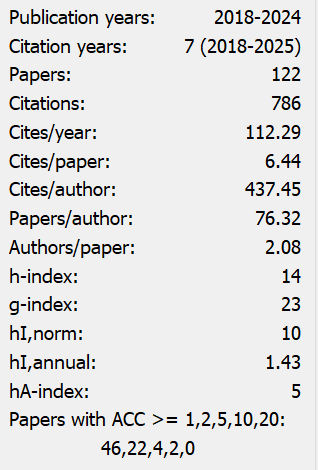Research on the Influence of Digital Inclusive Finance on New Agricultural Productivity
Abstract
With the deep integration of digital technology and financial services, digital inclusive finance is constantly showing its unique advantages-inclusiveness and efficiency. This study is devoted to revealing how digital inclusive finance has injected a steady stream of powerful forces into the new agricultural productivity while promoting the development of the new agricultural productivity, and also contributed to the agricultural reform. Based on the panel data of 30 provinces (autonomous regions and municipalities) in China from 2011 to 2022, this paper empirically tests the effect of digital inclusive finance on new agricultural productivity and its internal mechanism through two-way fixed effect model and intermediary effect model. The results show that digital inclusive finance can significantly improve the development of new agricultural productivity, and this conclusion is still valid after a series of robustness tests; The mechanism analysis shows that digital inclusive finance promotes the development level of new agricultural productivity through the high polarization of industrial structure; Heterogeneity analysis shows that the promotion effect of digital inclusive finance on new agricultural productivity is more significant in the southeast area of "Hu Huanyong Line" and high economic development areas; Accordingly, it is suggested to promote the deep integration of digital inclusiveness and agriculture in all directions, further optimize the allocation of rural industrial structure, and fully stimulate the potential energy of digital inclusive finance in rural areas. At the same time, implement the policy of regional differentiation, strengthen the regional balance of digital inclusive finance, and make full use of the "digital dividend" brought by digital inclusive finance to promote the development of new agricultural productivity.
References
[2] Li, X., & Liu, Y. (2021). How can digital inclusive finance promote rural entrepreneurship? Economic Management, 43(12), 24–40.
[3] Zhang, X. (2023). The path of digital inclusive finance promoting common prosperity under the background of rural revitalization. Finance and Accounting Communication, (22), 133–137.
[4] Li, B., & Xiao, Y. (2024). Empowering high-quality development of inclusive finance with data elements: Theoretical logic, practical problems, and path exploration. Southwest Finance, (07), 37–48.
[5] Feng, R., Chen, Z., & Ye, Y. (2021). Inclusive finance supports high-quality development of the real economy: Regional heterogeneity and mechanism testing. Financial Economics Research, 36(03), 45–61.
[6] Huang, J. (2024). Agricultural new quality productivity: Connotation and extension, potential and challenges, and development ideas. China Rural Observation, (05), 19–34.
[7] Luo, B. (2024). On the new quality productivity of agriculture. Reform, (04), 19–30.
[8] Liu, T., & Liu, J. (2024). Does moderate scale operation promote the formation of new agricultural productivity: Empirical analysis based on the framework of "productivity mode labor productivity". Reform, (10), 44–61.
[9] Li, Y., & Liu, D. (2024). Research on the mechanism of agricultural insurance promoting the development of agricultural new quality productivity. Finance and Economics, (07), 38–49.
[10] Huang, Q., & Sheng, F. (2024). New quality productivity system: Element characteristics, structural bearing, and functional orientation. Reform, (02), 15–24.
[11] Liu, F., Zhang, T., & Huang, P. (2024). Has digital inclusive finance improved income inequality: From the perspective of non-farm employment transfer of skilled workers. Southern Finance, (06), 3–17.
[12] Lang, X., Zhang, M., & Wang, J. (2021). Digital inclusive finance, financing constraints, and innovation of small and medium-sized enterprises: A study based on data from New Third Board enterprises. Southern Finance, (11), 13–25.
[13] Huang, Q., Li, Z., & Xiong, D. (2019). The poverty reduction effect and transmission mechanism of digital inclusive finance. Reform, (11), 90–101.
[14] Xu, Y., & Ji, X. (2024). The impact of digital inclusive finance on the integration of urban and rural capital factors in counties: Based on the perspective of the new binary transformation. Quantitative Economics, Technology and Economics Research, 41(02), 193–212.
[15] Wang, S., Song, L., & Liu, J. (2024). The impact and spatial effects of digital inclusive finance on improving green total factor productivity. Price Theory and Practice, (04), 174–179+226.
[16] Feng, H., & Wang, X. (2020). Research on the mechanism of rural industry integration development based on the theory of six industries: Micro data and case analysis of new business entities. Agricultural Economic Issues, (09), 64–76.
[17] Cheng, Y. (2022). The impact and mechanism of digital finance development on industrial structure. Southeast Academic, (05), 179–188.
[18] Dai, H., Wei, J., & Chen, Y. (2023). Research on the impact of digital inclusive finance on the resilience of China's agricultural economy. Price Theory and Practice, (08), 144–148.
[19] Wang, T., Yang, L., & Yang, G. (2024). Digital infrastructure, integration of rural tertiary industries, and common prosperity. East China Economic Management, 38(04), 93–103.
[20] Liang, K., & Liu, W. (2023). The impact of upgrading rural industrial structure on rural economic resilience. Economy and Management, 37(03), 63–73.
[21] Wang, J. (2024). New quality productivity: A theoretical framework and indicator system. Journal of Northwest University (Philosophy and Social Sciences Edition), 54(01), 35–44.
[22] Wang, J., & Wang, R. (2024). New quality productivity: Indicator construction and spatiotemporal evolution. Journal of Xi’an University of Finance and Economics, 37(01), 31–47.
[23] Guo, F., Wang, J., Wang, F., et al. (2020). Measuring the development of digital inclusive finance in China: Index compilation and spatial characteristics. Economics (Quarterly), 19(04), 1401–1418.
[24] Wang, W., Liu, Y., & Peng, D. (2015). Research on the industrial structure upgrading effect of population aging. China Industrial Economy, (11), 47–61.
[25] Cao, Z., Tu, Q., & Hu, Z. (2024). The impact of digital inclusive finance on the new quality productivity of agricultural enterprises: A mechanism analysis based on rural industrial integration. Journal of Hunan Agricultural University (Social Sciences Edition), 25(05), 106–116.
[26] Cao, Y. (2024). Research on the impact of digital new quality productivity on industrial chain resilience. Statistics and Decision Making, 40(10), 23–27.
[27] Wen, Z., & Ye, B. (2014). Mediation effect analysis: Development of methods and models. Advances in Psychological Science, 22(05), 731–745.

This work is licensed under a Creative Commons Attribution 4.0 International License.
Copyright for this article is retained by the author(s), with first publication rights granted to the journal.
This is an open-access article distributed under the terms and conditions of the Creative Commons Attribution license (http://creativecommons.org/licenses/by/4.0/).


























